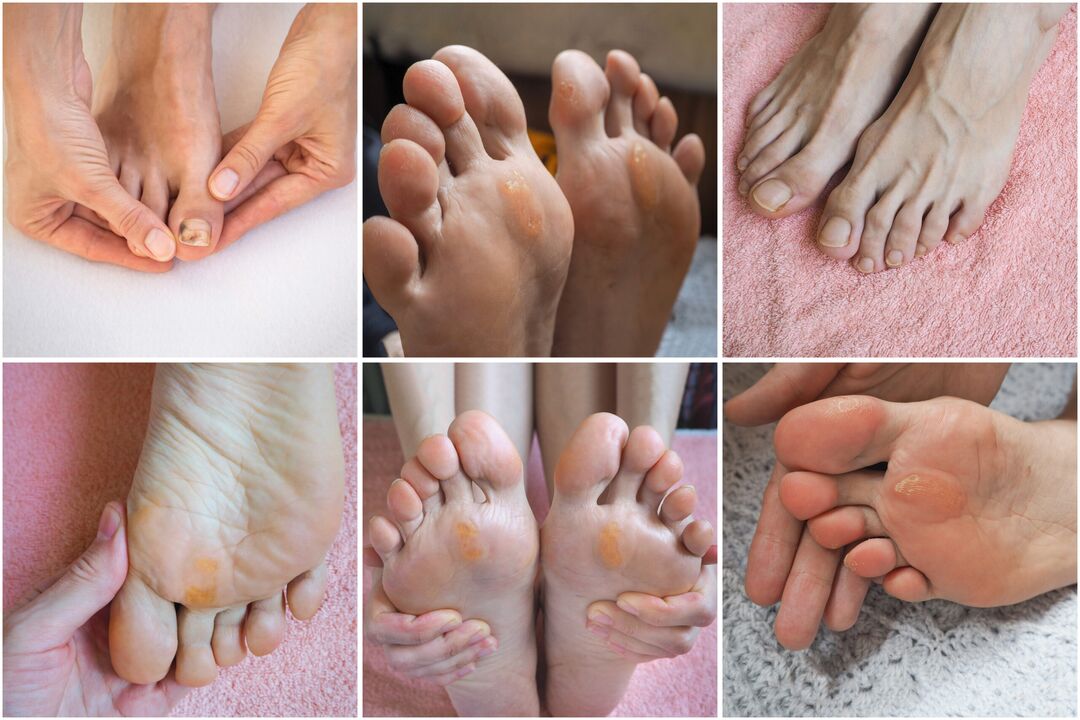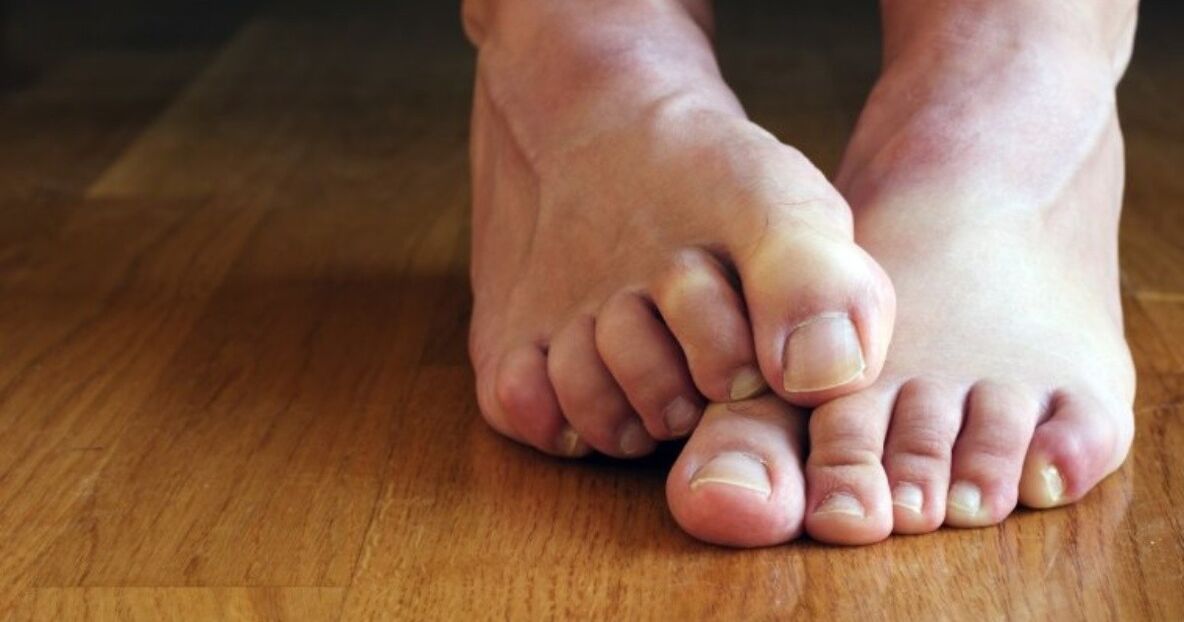In medical circles, mycosis refers to a group of diseases caused by fungi. If the skin is damaged, dermatomycosis is diagnosed, and if the nail plate is damaged, onychomycosis is diagnosed. In most images, pathologies are combined. Toe fungus occurs due to the negative effects of anthropophilic and zooanthropophilic microorganisms. An infection with yeast-like fungi of the Candida family occurs somewhat less frequently. Let's look at what types of fungal diseases occur and how to cure fungus between toes.
Types of mushrooms

Fungi are divided into different types: dermatophytes, molds and yeast-like parasites. They provoke the development of candidiasis, rubrophytosis, onychomycosis and epidermophytosis. Depending on the symptoms, further classifications are made into types. There are membranous, vesicular and moccasin forms of the disease.
For information: Infection occurs directly - through contact with the soil, vegetation, with a sick person or animal, or indirectly - through contact with household items touched by a sick person.
There are the following types of fungi on the skin between the toes:
- Athlete's foot. The pathology is accompanied by damage to the space between the toes and the nail plate. In most films, mature men are sick;
- Rubrophytia. The disease progresses slowly and there are no symptoms in the early stages of infection. Without proper treatment, the nail plate will soon be affected;
- Candidiasis of the interdigital space is relatively rare. Divided into several types. The first is vesicular-pustular. Characteristic signs include severe hyperemia and swelling. In the second - hyperkeratotic - the stratum corneum of the dermis thickens, severe peeling occurs;
- Intertriginous form. Diagnosed more often in summer. The space between the third and fourth toes is usually affected; a fungus is somewhat rarer on the little toe;
- The deleted form has a minimal number of symptoms. Patients complain of cracks in the interdigital space, slight burning and itching.
Treatment of interdigital fungus is prescribed after the specific pathogen is identified. For this purpose, the patient undergoes tests. Based on the results of laboratory diagnostics, a treatment regimen is recommended. Consists of medications for external use, tablets for internal use (in neglected scenes).
Causes of fungi and symptoms

Before learning how to treat toe fungus, let's consider the reason for the activation of pathogenic microflora and the symptoms of the disease. The main reason is undoubtedly the spread of fungi in the affected area.
You can become infected in public places when using other people's personal hygiene items; Infection often occurs within the family if a household member falls ill.
It is important to know: factors that increase a person's susceptibility to fungi include age - children are more sensitive due to immature defense mechanisms and the state of the immune system - a weakened body cannot resist the effects of fungi.
A fungus between the fingers arises for the following reasons:
- High humidity. This condition is caused by poor quality shoes, socks made of synthetic materials and hyperhidrosis of the lower extremities.
- Circulatory disorder. This problem is observed in chronic pathologies – diabetes, hypertension. It is also found in experienced smokers and alcohol abusers.
- Lower extremity injury. The fungus penetrates through the wound and begins to multiply quickly. Practice shows that even with good immunity, the body cannot cope on its own.
Other reasons include dermatological diseases – psoriasis, eczema, age, metabolic disorders in the body, etc.
Toe fungus is accompanied by constant itching and burning, which significantly affects the patient's quality of life. First, one finger is affected. However, if the disease is not diagnosed in a timely manner and treatment with anti-athlete's foot drugs is not initiated, the pathology quickly progresses and spreads to other fingers, feet and ankles.
Fungus between the fingers manifests itself as symptoms:
- peeling of the skin in the interdigital fold;
- The appearance of small cracks that cause discomfort;
- itching and pain in the affected area;
- Sealing the sole of the foot.
If the nail plate is damaged, the color of the nail changes and its natural shine is lost. The nail becomes thicker, is easily injured, crumbles and collapses.
The clinical symptoms are initially not very pronounced, the itching does not cause concern. As the disease progresses, the symptoms worsen. In most cases, the treatment of interdigital fungus on the toes requires taking two or more medications, as the picture worsens due to the patient's late request for help.
Methods for treating fungus
If fungus appears between your fingers, you should see a dermatologist. The doctor will conduct a physical examination and issue a referral for laboratory diagnostics. Based on the results, remedies for fungus on the feet between the toes are recommended.
How are pathogenic microorganisms eliminated? Local remedies help with this - creams, gels and ointments, sprays, emulsions. They do not enter the bloodstream and are used several times a day. Its use is recommended for mild fungal infections.
If an advanced fungal infection is diagnosed and the problem area is large, oral tablets are prescribed. They act from within and destroy the cell membrane of parasites, leading to their death. The doctor determines both the type of application and the dosage independently; If the recommended dose is exceeded, side effects may occur.
You can treat fungus between your toes with the following medications:
- Tablet form.
- Local agents.
You can supplement the medical treatment of fungus between the toes with folk remedies - baths based on chamomile, baking soda, lotions with laundry soap, vinegar and other ingredients of natural origin.
Important: To ensure the effectiveness of treatment, confirmation by laboratory methods is required - the analysis is carried out after 14 days of therapy and after 30 days. Only negative results indicate the effectiveness of the course.
Antifungal agent
An antifungal is an antifungal drug; it helps remove fungus and works quickly and effectively. The medication is only taken on the advice of a doctor. The drug has different release forms – gel, spray, cream and tablets, solution.
The principle of action of the drug is to block the ability of fungi to reproduce, as a result of which they die. When applied externally, the product accumulates in the affected area, which contributes to its high effectiveness.
The dosage of the tablet form for an adult is usually 250 mg per day. If a child is being treated for a fungus, the dose is based on body weight. The duration of the therapy course varies between 2 and 6 weeks. Spray and ointment are used 1-2 times a day. The treatment lasts 1 month. If recommended by the doctor, the duration of treatment can be extended by several weeks.
Side effects of the tablets:
- Headache;
- Impaired taste perception;
- Dizziness;
- Allergic reaction;
- Decreased appetite;
- Disturbance of the digestive tract;
- nausea, vomiting;
- Painful sensations in the abdomen.
Contraindications to use are organic intolerance to the drug, impaired liver and kidney function. Reviews of patients note that the product quickly relieves unpleasant symptoms - after a few days of treatment, the severity of clinical manifestations decreases.
Antimycotic for systemic use against fungi
Dosage forms – ointment, cream, spray and tablets. Often prescribed to treat a fungal infection between the toes. The ointment/cream is applied in a thin layer to a dried and clean area of skin. Rubbing is not recommended. The frequency of application is twice daily.
The dosage of the tablets is determined individually. The reception takes place over several weeks. For children, the dose depends on weight and age. The drug has a harmful effect on pathogenic microorganisms and is an effective remedy. Tablets should not be prescribed in the following situations:
- liver dysfunction;
- lactose intolerance;
- pregnancy, breastfeeding;
- hypersensitivity;
- children under three years old;
- Patient weight up to 20 kg.
Important: Taking antifungals and alcohol at the same time increases the likelihood of toxic liver damage.
Such creams are well tolerated. Only some patients experience allergic reactions. In this case, the medication prescriptions should be adjusted. You cannot choose analogues yourself.
To prevent the appearance of fungi, it is recommended to treat shoes with antifungal drugs; Strictly follow all doctor's recommendations and do not stop treatment. observe the hygiene rules; After water treatment, wipe your feet dry.


















